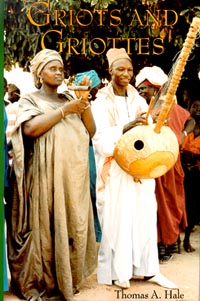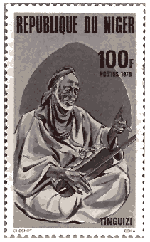
by Thomas A. Hale
Indiana University Press, 1998, 335 pp.
It is fair to say that America learned about griots (Africa's genealogical storytellers) from Alex Haley's Roots. For Haley and for his American audience, the pivotal moment in his quest to reconstruct his family's story comes when, in the Gambian village of Juffure, he hears from a griot about the African side of his family's origins and about the capture by slavers in the mid-18th century of his Mandenka ancestor Kunte Kenteh. Now, more than thirty years since that encounter, West African griot storytellers are more familiar to world music audiences. Typically, griots capture our imagination as musicians�another role of the hereditary caste. Yet even the knowledge of those two roles fails to portray fully the complex history and place held by these icons of African culture. But Thomas Hale helps fill that void as he ambles into his story, Griots and Griottes, taking his readers into the cultures from which these practitioners arise.
His first chapter, "A Job Description for Griots," explains how much more there is to griot practice than simply genealogy and music. Griots in Mali, Niger, Senegal, and Gambia variously serve as village historian, royal advisor, diplomat, mediator, teacher, exhorter, witness, praise singer and key participant at the important village ceremonies. Because this range of roles was seldom fully witnessed by those travelers of the last several centuries who wrote about griots, understanding of what these court artists did to earn their keep was flawed. "No other profession in any other part of the world is charged with such wide-ranging and intimate involvement in the lives of people," says Hale. Hale continues by examining the shrouded mythology that depicts the origins of the griot practice.
 Although the griots in West Africa arise from many ethnic and linguistic traditions, whatever their origins, many consider all or some of their roots to be tied to the thirteenth-century Malian empire and its founder, Sundiata Keita. The basic tale of griot origins involves blood sacrifice and is used to explain taboos associated with griots and why their caste is distinct from that of other West African villagers. As Islam came to the region and griot social status became memorialized in epic narratives, their unique social situation was witnessed and reported by outsiders, first Arab and later European. Hale traces these contacts and describes many of the partial glimpses had by those visitors of the griot world.
Although the griots in West Africa arise from many ethnic and linguistic traditions, whatever their origins, many consider all or some of their roots to be tied to the thirteenth-century Malian empire and its founder, Sundiata Keita. The basic tale of griot origins involves blood sacrifice and is used to explain taboos associated with griots and why their caste is distinct from that of other West African villagers. As Islam came to the region and griot social status became memorialized in epic narratives, their unique social situation was witnessed and reported by outsiders, first Arab and later European. Hale traces these contacts and describes many of the partial glimpses had by those visitors of the griot world.
With solid groundwork laid for the reader, Hale pursues yet another level to explain griots, their culture, and how it is they practice their verbal art. One of their most notable practices, praise singing, is examined, as well as the techniques employed to recount genealogies, tales, songs, poems and proverbs. Less known, and once controversial and doubted, was the existence of "epic" in African oral tradition. Hale works with these epics and distinguishes them from European tradition and scholarship. In "The Verbal Art of Griots" and in "Music Across the Griot World" he goes on to discuss the instruments and techniques used to support these narratives in a highly accessible and informative manner.
 So, with 700+ years of development, where does this craft stand at the end of the 20th century? First through the exposure brought about by the publication of Roots, then through expanded contacts and increased understanding of griots, the West continues to learn that Africa was more cultured and sophisticated than our history books taught us to imagine. In some respects, the griots have historically synthesized their cultures' experience and through the examples conveyed in their tales these wordsmiths exercised their power and profession. In "The Making of a Griot," and "Would You Want Your Daughter to Marry One," the traditional social place of the Griot is further examined within the ever growing influence of modernity and change. The rigid place of birth and apprenticeship have begun to give way to state-sponsored training programs even while some of the griot masters emigrate to Europe and the United States. Many readers will find in the chapter "Griottes: Unrecognized Female Voices" important new scholarship research trends into the world of women practitioners and performers.
So, with 700+ years of development, where does this craft stand at the end of the 20th century? First through the exposure brought about by the publication of Roots, then through expanded contacts and increased understanding of griots, the West continues to learn that Africa was more cultured and sophisticated than our history books taught us to imagine. In some respects, the griots have historically synthesized their cultures' experience and through the examples conveyed in their tales these wordsmiths exercised their power and profession. In "The Making of a Griot," and "Would You Want Your Daughter to Marry One," the traditional social place of the Griot is further examined within the ever growing influence of modernity and change. The rigid place of birth and apprenticeship have begun to give way to state-sponsored training programs even while some of the griot masters emigrate to Europe and the United States. Many readers will find in the chapter "Griottes: Unrecognized Female Voices" important new scholarship research trends into the world of women practitioners and performers.
Finally, Griots and Griottes pictures a tradition facing its future. With "From the Courtyards of the Nobility to a Global Audience" and "New Millenium Griots" we witness both change and continuity. Sure, some have plugged in and others participate in an array of "world music" sounds that make instruments such as the kora ever more familiar. As that process goes on, some critics raise charges of cultural imperialism, yet others welcome the chance for griots to seize opportunities to practice their art on a global scale. And why shouldn't they? These technological opportunities have, if anything, revitalized the griot as a societal touchstone, a place quite properly theirs. "Paved roads, air transportation, telephone, radio, television, audio and video recordings, satellite communication, printing, and the Internet all help bring the words of griots to these new audiences," Hale points out. That opportunity will help griots and griottes alike to continue their very basic role "as people who articulate the models for appropriate social behavior," first in their own cultures and now in others. Legitimate questions do persist, however, and whether outside forces ultimately "overpower" the African griot craft will take time to answer.
Griots and Griottes is a book worth waiting for. Its origins are, in part, a legacy of President Kennedy's Peace Corps, in which Hale's two year stint as a volunteer in Niger (1964-66) provided him with his first encounters with griots. One can't help but speculate what other books linger out there among former Peace Corps volunteers, a career and half a lifetime later.
- Richard Dorsett
see also: Africa